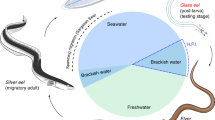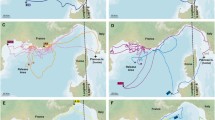Abstract
Loggerhead sea turtle hatchlings emerge from nests on either the east or west coast of the South Florida peninsula and then migrate offshore in opposite directions. Under laboratory conditions, magnetic cues induce east coast hatchlings to swim in directions that promote their transport by oceanic surface currents, such as the North Atlantic gyre. However, the surface currents used by west coast hatchlings are unknown. We examined the responses of west (Sarasota) hatchlings to magnetic cues in the Gulf of Mexico, the Florida Straits, and the Gulf Stream to determine their (1) likely migratory routes (2) orientation where currents lead into the Atlantic Ocean, and (3) orientation adjacent to Florida’s east coast. The results suggest that migration inside Gulf waters may be circuitous, that the turtles respond appropriately to enter Atlantic waters, and that orientation along Florida’s east coast probably promotes transport by the Gulf Stream into the North Atlantic gyre.





Similar content being viewed by others
References
Batschelet E (1981) Circular statistics in biology. Academic Press, London
Bjorndal KA, Meylan AB, Turner BJ (1983) Sea turtle nesting at Melbourne Beach, Florida, I. size, growth and reproductive biology. Conservation 26:65–77
Bjorndal KA, Bolten AB, Martins HR (2000) Somatic growth model of juvenile loggerhead sea turtles Caretta caretta: duration of pelagic stage. Mar Ecol Prog Ser 202:265–272
Bjorndal KA, Bolten AB, Koitke B, Schroeder BA, Shaver DJ, Teas WG, Witzell WN (2001) Somatic growth function for immature loggerhead sea turtles, Caretta caretta, in southeastern U.S. waters. Fish Bull (Wash D C) 99(2):240–246
Bolten AB (2003a) Variation in sea turtle life history patterns: neritic vs. oceanic development stages. In: Lutz PL, Musick JA (eds) The biology of sea turtles. CRC Press, Boca Raton, pp 243–257
Bolten AB (2003b) Active swimmers-passive drifters: the oceanic juvenile stage of loggerheads in the Atlantic system. In: Bolten AB, Witherington BE (eds) Loggerhead sea turtles. Smithsonian Books, Washington, pp 63–78
Bolten AB, Balazs GH (1995) Biology of the early pelagic stage—the “lost year”. In: Bjorndal KA (ed) Biology and conservation of sea turtles. Smithsonian Institution Press, Washington DC, pp 579–581
Bolten AB, Martinas HR, Bjorndal KA, Gordon J (1993) Size distribution of pelagic-stage loggerhead sea turtles (Caretta caretta) in the waters around the Azores and Madeira. Arquipélago 11A:49–54
Bolten AB, Bjorndal KA, Martins HR, Dellinger T, Biscoito MJ, Encalada SE, Bowen BW (1998) Transatlantic developmental migrations of loggerhead sea turtles demonstrated by mtDNA sequence analysis. Ecol Appl 8:1–7
Bowen BW, Avise JC (1995) Conservation genetics of marine turtles. In: Avise JC, Hamrick JL (eds) Conservation genetics: case histories from nature. Columbia University Press, New York, pp 190–237
Bowen BW, Karl S (2007) Population genetics and phylogeography of sea turtles. Mol Ecol 16:4886–4907
Bowen BW, Avise JC, Richardson JI, Meylan AB, Margaritoulis D, Hopkins-Murphy SR (1993) Population structure of loggerhead turtles (Caretta caretta) in the northwestern Atlantic Ocean and Mediterranean Sea. Conserv Biol 7:834–843
Carr AF (1967) So excellent a fish: a natural history of sea turtles. Scribner, New York
Carr A (1986) Rips, FADS, and little loggerheads. Bioscience 36:92–100
Carr A (1987) Reproduction and migrations of the Ascension Island green turtle Chelonia mydas. Copeia 1:103–113
Carr AF, Carr MH, Meylan AB (1978) The ecology and migration of sea turtles, 7. The West Caribbean green turtle colony. Bull Am Mus Nat Hist 162:1–46
Carson HL (1971) Speciation and the founder principle. Univ Montana Stadler Genetic Symp 3:51–70
Carson HL (1982) Evolution of Drosophila on the newer Hawaiian volcanoes. Heredity 48:3–25
Cheng I, Wang Y (2009) Influence of surface currents on post-nesting migration of green sea turtles nesting on Wan-An Island, Penghu Archipelago, Taiwan. J Mar Sci Tech 17(4):306–311
Collard SB, Ogren L (1990) Dispersal scenarios for pelagic post-hatchling sea turtles. Bull Mar Sci 47:233–243
Crandall KA, Bininda-Emonds ORP, Mace GM, Wayne RK (2000) Considering evolutionary processes in conservation biology. TREE 15:290–295
Encalada SE, Bjorndal KA, Bolten AB, Zurita JC, Schroeder B, Possardt E, Sears CJ, Bowen BW (1998) Population structure of loggerhead turtle (Caretta caretta) nesting colonies in the Atlantic and Mediterranean as inferred from mitochondrial DNA control region sequences. Mar Biol 130:567–575
Fraser DJ, Bernatchez L (2001) Adaptive evolutionary conservation: towards a unified concept for defining conservation units. Mol Ecol 10:2741–2751
Fuxjager MJ, Mangiamele LA, Davidoff KRB, Lohmann KJ (2005) Effects of the magnetic environment of sea turtle nests on magnetic orientation behavior in hatchlings. Integr Comp Biol 45:999 (abstract)
Girard C, Tucker AD, Calmettes B (2009) Post-nesting migration of loggerhead sea turtles in the Gulf of Mexico: dispersal in highly dynamic conditions. Mar Biol 156(9):1827–1839
Gyory J, Mariano AJ, Ryan EH (2005) “The Loop Current.” Ocean Surface Currents. http://oceancurrents.rsmas.miami.edu/atlantic/loop-current.html. Accessed 13 March 2008
Irwin WP, Horner A, Lohmann KJ (2004) Magnetic field distortions produced by protective cages around sea turtle nests: unintended consequences for orientation and navigation. Biol Conserv 118:117–120
LeBuff CR Jr (1990) The Loggerhead Turtle in the eastern Gulf of Mexico. Caretta Research, Sanibel
Light P, Salmon M, Lohmann KJ (1993) Geomagnetic orientation of loggerhead sea turtles: evidence for an inclination compass. J Exp Biol 182:1–10
Liu Y, Weisberg R (2007) Ocean currents and sea surface heights estimated across the West Florida Shelf. J Phy Ocean 37:1697–1713
Lohmann KJ (1991) Magnetic orientation by hatchling loggerhead sea turtles (Caretta caretta). J Exp Biol 155:37–49
Lohmann KJ (2010) Magnetic-field perception. Nature 464:1140–1142
Lohmann KJ, Lohmann CMF (1993) A light-independent magnetic compass in the leatherback sea turtle. Biol Bull Woods Hole 185:149–151
Lohmann KJ, Lohmann CMF (1994a) Detection of magnetic inclination angle by sea turtles: a possible mechanism for determining latitude. J Exp Biol 194:23–32
Lohmann KJ, Lohmann CMF (1994b) Acquisition of magnetic directional preference in hatchling loggerhead sea turtles. J Exp Biol 190:1–8
Lohmann KJ, Lohmann CMF (1996) Detection of magnetic field intensity by sea turtles. Nature 380:59–61
Lohmann KJ, Lohmann CMF (1998) Migratory guidance mechanisms in marine turtles. J Avian Biol 29:585–596
Lohmann KJ, Lohmann CMF (2003) Orientation mechanisms of hatchling loggerheads. In: Bolton AB, Witherington BE (eds) Loggerhead Sea Turtles. Smithsonian Books, Washington DC, pp 44–62
Lohmann KJ, Lohmann CMF (2006) Sea turtles, lobsters, and oceanic magnetic maps. Mar Freshw Behav Physiol 39:49–64
Lohmann KJ, Witherington BE, Lohmann CMF, Salmon M (1997) Orientation, navigation, and natal beach homing in sea turtles. In: Lutz PL, Musick JA (eds) The biology of sea turtles. CRC Press, Boca Raton, pp 107–135
Lohmann KJ, Hester JT, Lohmann CMF (1999) Long-distance navigation in sea turtles. Ethol Ecol Evol 11:1–23
Lohmann KJ, Cain SD, Dodge SA, Lohmann CMF (2001) Regional magnetic fields as navigational markers for sea turtles. Science 294:364–366
Lohmann KJ, Lohmann CMF, Putman NF (2007) Magnetic maps in animals: nature’s GPS. J Exp Biol 210:3697–3705
Lohmann KJ, Luschi P, Hays GC (2008) Goal navigation and island-finding in sea turtles. J Exp Mar Biol Ecol 356:83–95
Mansfield KL, Wyneken J, Rittschoff D (2010) Tracking neonate loggerhead (Caretta caretta) sea turtles using satellite telemetry. Abstract submitted to: 30th Annual Symposium on Sea Turtle Biology and Conservation, Goa, India (in press)
Merritt R, Purcell C, Stroink G (1983) Uniform magnetic field produced by three, four and five square coils. Rev Sci Inst 54:879–882
Meylan A, Schroeder B, Mosier A (1995) Sea turtle nesting activity in the state of Florida 1979–1992. Fl Mar Res Pub 52:1–51
Molinari RL (1980) Current variability and its relation to sea-surface topography in the Caribbean Sea and the Gulf of Mexico. Mar Geod 3:409–436
Moritz C (1994) Defining ‘evolutionary significant units’ for conservation. TREE 9:373–375
Murphy T, Hopkins S (1984) Aerial and ground surveys of marine turtle nesting beaches in the southeast region. Final Report, National Marine Fisheries Service
NOAA National Data Buoy Center (2006, October 3) “Florida and Eastern Gulf of Mexico Recent Marine Data”. http://www.ndbc.noaa.gov/maps/Florida.shtml. Accessed 13 March 2008
Pearce A (2001) Contrasting population structure of the loggerhead turtle (Caretta caretta) using mitochondrial and nuclear DNA markers. Master’s thesis, University of Florida, Gainesville
Salmon M, Wyneken J (1987) Orientation and swimming behavior of hatchling loggerhead turtles Caretta caretta L. during their offshore migration. J Exp Mar Biol Ecol 109:137–153
Shamblin B (2007) Population structure of loggerhead sea turtles (Caretta caretta) nesting in the southeastern United States inferred from mitochondrial DNA sequences and microsatellite loci. Masters Thesis, University of Georgia, Athens
Stewart KR, Wyneken J (2004) Predation risk to loggerhead hatchlings at a high-density nesting beach in Southeast Florida. Bull Mar Sci 74:325–335
Sturges W, Lugo-Fernández A (2005) Circulation in the Gulf of Mexico: observations and models. American Geophysical Union, Washington DC
Templeton AR (1980) The theory of speciation via the founder principle. Genetics 94:1011–1038
Tucker AD (2010) Nest site fidelity and clutch frequency of loggerhead turtles are better elucidated by satellite telemetry than by nocturnal tagging efforts: Implications for stock estimation. J Exp Mar Biol Ecol 383:48–55
Weisberg RH, Black BD, Li Z (2000) An upwelling case study on Florida’s west coast. J Geo Res 105(5):11:459–11,469
West-Eberhard MJ (2003) Developmental plasticity and evolution. Oxford University Press, Oxford
Whelan CL, Wyneken J (2007) Estimating predation levels and site-specific survival of hatchling loggerhead sea turtles (Caretta caretta) from south Florida beaches. Copeia 3:745–754
Witherington BE (2002) Ecology of neonate loggerhead turtles inhabiting lines of downwelling near a Gulf Stream front. Mar Biol 140:843–853
Witherington BE, Hirama S (2006) Sea turtles of the epi-pelagic Sargassum drift community. In: Frick M, Panagopoulou A, Rees AF, Williams K. (compilers), Book of Abstracts. 26th Annual Symposium on Sea Turtle Biology and Conservation Athens, Greece, p 209
Witherington BE, Bjorndal KA, McCabe CM (1990) Temporal pattern of nocturnal emergence of loggerhead turtle hatchlings from natural nests. Copeia 4:1165–1168
Witherington BE, Kubilis P, Brost B, Meylan A (2009) Decreasing annual nest counts in a globally important loggerhead sea turtle population. Ecol App 19:30–54
Wyneken J, Salmon M (1992) Frenzy and postfrenzy swimming activity in loggerhead, green, and leatherback hatchling sea turtles. Copeia 2:478–484
Wyneken J, Madrak SV, Salmon M, Foote J (2008) Migratory activity by hatchling loggerhead sea turtles (Caretta caretta L.): evidence for divergence between nesting groups. Mar Biol 156:171–178
Zar JH (1999) Biostatistical analysis. Prentice Hall, Englewood Cliffs
Acknowledgments
This study was completed by MWM in partial fulfillment of the requirements for a Masters of Science degree in the Department of Biological Sciences, Florida Atlantic University (FAU). It was supported by several scholarship awards for students in Marine Biology and by generous contributions to the Nelligan Fund for Sea Turtle Research at FAU. We extend our special thanks to K. J. Lohmann for his advice and guidance and for allowing us to calibrate our old magnetometer against his new one. A. D. Tucker and his marine turtle group provided access to nests, while W. N. Tavolga provided laboratory space that made our work at the Mote Marine Laboratory possible. S. Kajiura and A. D. Tucker served on the thesis committee; their suggestions improved the thesis. J. Wyneken kindly reviewed the manuscript before submission. The comments of two referees improved the manuscript after submission. MWM extends her special thanks to family and friends for their encouragement and unwavering support. This study was carried out under permits issued by the Florida Fish and Wildlife Conservation Commission (TP 173) and by the FAU Institutional Animal Care Committee (Protocol A08-2a).
Author information
Authors and Affiliations
Corresponding author
Additional information
Communicated by R. Lewison.
Rights and permissions
About this article
Cite this article
Merrill, M.W., Salmon, M. Magnetic orientation by hatchling loggerhead sea turtles (Caretta caretta) from the Gulf of Mexico. Mar Biol 158, 101–112 (2011). https://doi.org/10.1007/s00227-010-1545-y
Received:
Accepted:
Published:
Issue Date:
DOI: https://doi.org/10.1007/s00227-010-1545-y




